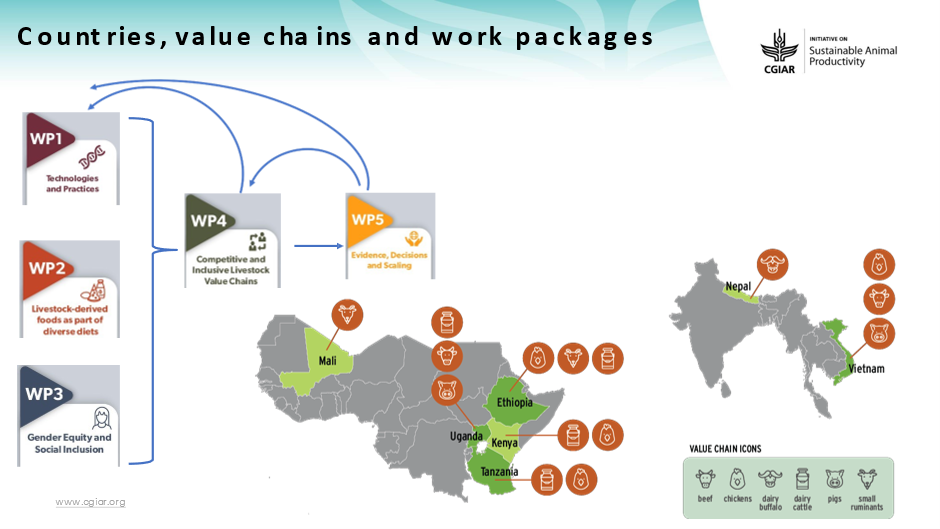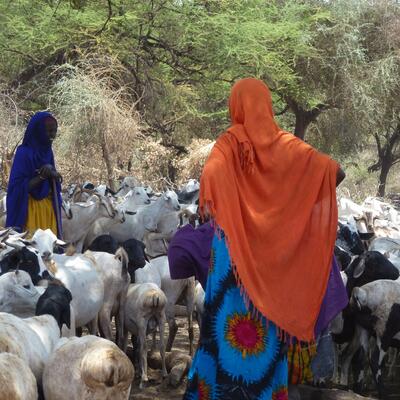

Three years, seven countries: Lessons learned from the CGIAR SAPLING Initiative
Conceived during the COVID-19 pandemic, the CGIAR Initiative on Sustainable Animal Productivity for Livelihoods, Income, Nutrition and Gender Inclusion (SAPLING) Initiative kicked off in 2022 and is nearing completion.
As the world was opening again, SAPLING embodied our desire to rekindle and spark new collaboration across CGIAR centres, countries and value chains. Working across seven countries, this three-year initiative focused on selected livestock value chains to package and scale out tried-and-tested and new innovations in animal health, genetics, feed and market systems. Research work has been going on in Ethiopia, Kenya, Nepal, Mali, Tanzania, Uganda and Vietnam.

Map of SAPLING countries, work packages and value chains (photo credit: CGIAR).
SAPLING aimed to show that improvements in livestock productivity can offer a triple win: improving livelihoods and nutritional outcomes, contributing to women’s empowerment and reducing impacts on climate and the environment. The value chains of focus were cattle, chickens, small ruminants, pigs and buffaloes.
Ambitious from the start, SAPLING has made quite an impact, but not without challenges and lessons learned. The team, led by SAPLING initiative lead Isabelle Baltenweck, held a close-out meeting on 5 December 2024 to reflect on and share experiences.
What worked well
- The monitoring, evaluation, learning and impact assessment (MELIA) portal: An effective reporting system in place from the beginning, together with a strong support team, contributed to smooth operations and reporting.
- The team’s adaptability through COVID-19: Swiftly transitioning to online tools enabled easy remote collaboration, facilitating cross-country learning throughout.
- Frequent and open communication channels overall: Various teams held monthly update meetings, and the entire team held annual in-person team building and reflection, which fostered a better understanding of field activities, progress made, and support needed.
What could have been better
- Collaboration between centres: Differences in and unclear funding delayed and changed the desired outcomes.
- Poor coordination and communication between value chains and work package teams: Lack of day-to-day communication at SAPLING’s value chain and initiative levels resulted in poor actionable follow-ups.
- Implementation challenges: Different centres had different budget capacities, leading to disparities in project execution.
Consequently, all these challenges contributed to delayed or incomplete planning documents and reports.
Impact and success stories
According to the CGIAR initiatives' results and impacts dashboard, the initiative has, in the three years (2022-2024), reported over 900 knowledge products such as research briefs, reports and more; developed over 900 innovations; conducted over 1500 capacity building for development; recorded over 200 use of innovations use and influenced over 130 policy changes. Here are a few success stories:
- Increase in productivity across value chains: In the seven target countries, smallholder productivity has improved by over 50%. In Ethiopia, Kenya and Tanzania, an over 50% increase in smallholder poultry producers’ productivity was recorded due to the use of integrated intervention promoted by SAPLING.
- Integration of breeding research in national policies: In Ethiopia, Kenya and Uganda, SAPLING research work influenced breeding certification policies and stakeholder workshops to deliberate on the same. New applications, such as the Africa-Asia Dairy Genetics Gains mobile app, were also developed during this phase, and thousands of new beneficiaries were recorded.
- The scaling of the gender program in terms of gender and women's empowerment in Tanzania and Vietnam was noted through programs initiated to challenge norms that lock women out while encouraging men to support them more.
Some lessons learned
- Better results when a country leader strongly identifies with SAPLING.
- Significant trust and outcome setbacks from budget cuts.
- The need for strategic partner identification in the future to leverage co-funding opportunities
- More clarity on the expected outcomes further in advance to ensure planning and reporting.
Moving forward
Throughout the initiative, SAPLING has worked closely with partners from research centres, development and the private sector. This co-creation and collaborative effort has been instrumental in developing and implementing research strategies, innovations, technologies, tools and evidence that will continue after this initiative ends. SAPLING’s successes and challenges highlight lessons learned, shaping the new CGIAR science programs towards better research that informs evidence-based policies for sustainable growth of the livestock sector and increased investments.
You may also like
ILRI News
Four-year initiative launched to improve milk quality, safety and marketing in central and western Kenya

ILRI News
Scaling up gender-sensitive livestock innovation packages boosts sustainable animal productivity and livelihoods in Mali
ILRI News
High-quality cassava peel mash technology: Global reach, dissemination, and adoption beyond Africa
Related Publications

A positive deviance approach to understand gender relations and practices that support transformative adaptation: Insights from Kenya dairy households
- Bullock, Renee
- DuttaGupta, Tanaya
- Miriti, Philip

Empowering Community Rangeland Health Workers: A Novel Path to Sustainable Ecosystem Management in Ethiopia
- Eba, Bedasa

The Role of P-PD in Enhancing the Ethiopian Livestock Extension System
- Habermann, Birgit
- Worku, Tigist
- Getahun, Elizabeth

Herd health innovations improve pig farmers’ knowledge and uptake of husbandry practices in Uganda
- Oba, Peter
- Businge, Martha
- Hasahya, Emmanuel
- Dione, Michel M.
- Kawuma, Peter
- Wairagala, Pamela
- Bamundaga, Geoffrey
- Ahumuza, Ronnie
- Kaweesa, Peter
- Namatovu, Jane
- Kalenzi, Moses S.
- Achandi, Esther L.
- Ouma, Emily A.












